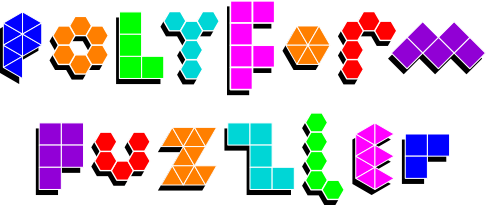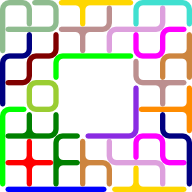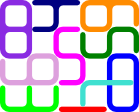Polysticks: Puzzles & Solutions
| Author: | David Goodger <goodger@python.org> |
|---|---|
| Date: | 2015-02-24 |
| Revision: | 600 |
| Web site: | http://puzzler.sourceforge.net/ |
| Copyright: | © 1998-2015 by David J. Goodger |
| License: | GPL 2 |

Contents
Polysticks of Order 1 Through 3
These puzzles use the 1 monostick, 2 disticks, and 5 tristicks, for a total of 20 line segments on the square grid.
4x4 grid with clipped corners:
Tetrasticks
One-Sided Welded Tetrasticks
The "welded" tetrasticks are those that contain junction points, or welds, and therefore do not form simple connected paths (in other words, they branch). There are 6 welded tetrasticks, 4 of which are asymmetrical, therefore there are 10 one-sided welded tetrasticks.
5x5 grid: 3 solutions

Triangle: 9 solutions

Trapezoid: 7 solutions

15 of 16 Tetrasticks
Due to an imbalance in horizontal/vertical parity, the 16 tetrasticks cannot be formed into a symmetrical shape. But by omitting one of the five tetrasticks that have an excess of 2 vertical or horizontal line segments (H, J, L, N, or Y), symmetrical shapes can be formed.
6x6 grid: 1795 solutions
In this solution, the "Y" piece is omitted:

Aztec Diamond of order 3: 3 solutions
In this solution, the "J" piece is omitted:

One-Sided Tetrasticks
9 of the 16 tetrasticks are asymmetrical, therefore there are 25 one-sided tetrasticks.
5x5 diamond lattice: 107 solutions

Calculating all 107 non-isomorphic solutions took approximately 11 weeks using one core of a 2.66GHz Intel Core 2 Duo E6750 CPU (Python 2.6.6, Windows XP) on an otherwise idle and always-on machine. The calculated solutions correspond to those listed in "Covering the Aztec Diamond with One-sided Tetrasticks, Extended Version", by Alfred Wassermann, University of Bayreuth. (Wassermann, and Knuth before him, mistakenly called the shape an "aztec diamond", but an aztec diamond is a subtly different shape. This puzzle actually corresponds to a centered square number.)
The solution above is number 9 in Wassermann's paper, and number 58 in the Polyform Puzzler solutions. Both Wassermann's and the Polyform Puzzler solution sets are split into six sub-puzzles by position of the "X" piece, and correspond as follows:
X-Position (sub-puzzle) Polyform Puzzler Wassermann Solutions A (symmetrical) 6 19 B 5 36 C (symmetrical) 2 11 D 4 19 E 1 15 F 3 7 Note: The Polyform Puzzler order for the X-positions is in increasing distance from the center of the puzzle. Wassermann's order is as follows: with all X-piece possitions in the upper-left quadrant in two horizontal rows (rotate the diagrams in the paper 90° clockwise), ordered from left to right, top to bottom. Symmetrical X-positions (X-piece on the diagonal) have the I-piece limited to horizontal for both Polyform Puzzler and Wassermann (when rotated as noted above).
8x8 grid with center hole: solutions incomplete

8x8 grid with one clipped corner: solutions incomplete

8x8 grid with two clipped corners 1: solutions incomplete

X (designed for G4G10):
10x5 trapezoid: solutions incomplete

Polysticks of Order 1 Through 4
These puzzles use the 1 monostick, 2 disticks, 5 tristicks, and 16 tetrasticks, for a total of 84 line segments.
7x7 grid: solutions incomplete

10x5 grid (with a hole): solutions incomplete

3x7 diamond lattice: solutions incomplete

Truncated diamond lattices:
6x4: solutions incomplete

8x3: solutions incomplete

12x2: solutions incomplete

Octagons:
Four overlapping squares: solutions incomplete

Three overlapping squares: solutions incomplete

Seven-Segment Digits
The pieces in this puzzle are modeled after the seven-segment display digits 0 through 9, as seen on digital watches, for a total of 49 line segments. Based on the "Digigrams" puzzle (AKA "Count On Me" or "Count Me In") by Martin H. Watson.
In the following puzzle, the digit pairs (2, 5) and (6, 9) are considered identical for the sake of counting solutions (preventing duplicate solutions). Also note that the 0 digit has a gap in one long side, allowing the 1 or 7 digit to intersect and occupy the 0 digit's otherwise enclosed central line segment.
6x5 grid: 5 solutions

Unfortunately, there are no solutions where all of the digits are unflipped. For example, in the solution above, the green 2 digit is flipped and appears as a second 5.





